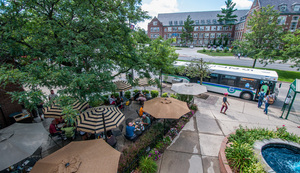Closing the Town-Gown Divide
Author: Marilyn Hecht
One important part to a city, particularly a university city, is the correspondence between the local community and the university setting. Many university or college town face the discrepancy of the Town-Gown divide, where there is a lack of connection between the people who live in the town versus the people and culture that derives from the university. By closing the gap between these two identities and cultures, it has the possibility to create a globalized and economically booming environment.
Universities are centers of higher learning that tend to spark an environment of change within the culture and it cause clash within the local community. But this sense of “change” allows for growth in the increasingly globalized economy. Research-based institutions also stimulate this economic growth by promoting change and increasing intellectual capital. Richard Florida, an urban theorist, claims that the global economy is pushed by talented individuals that in the end, create a vibrant and interactive city. These ideas and personalities can arise through the connection of this divide between the university and the town.
involvement in the decision process because the campus-development can cause issues with traffic or a decrease in tax revenue without the consent of the community. As long as these issues are discussed before development begins, the relationship between the university and the local community will thrive. It also is beneficial if the university and the town have the same goal in mind such as attracting creative and talented people into the area. By working together, both the university and the town could benefit economically by attracting these individuals.
The city of East Lansing draws as a perfect environment to implement this principle into a university-city divide. The Greater Lansing Area is the home of Michigan State University that seems to border the local community and university community through the streets of Grand River Ave. and Michigan Ave. One way to close this gap is through the mixed use of old and new buildings. New technological advances mixed into the old building by creating modern businesses that attract the local and university people, such as a grocery store. This can support local businesses why also attracting the young talent the university could be searching for.
By focusing on the town-gown divide, both the university and the local community can work together to stimulate their economy and attract up-and-coming individuals. But it is also important to have community voice to make sure that the community will have the ability to thrive due to new project construction. This gap will then produce more businesses and growth to stimulate the local economy and should be able to bring the communities together over a shared identity. Overall, this principle, if implemented correctly, will have the possibility to benefit both communities while keeping the identity and culture alive.
An example of this principle at work: Planning for Higher Education
Back